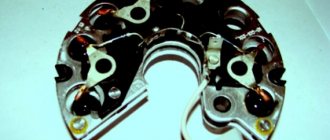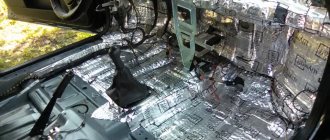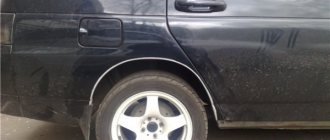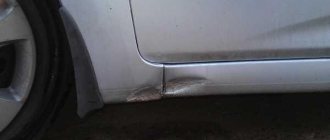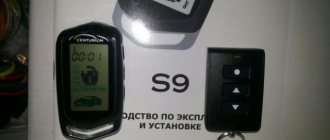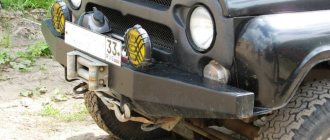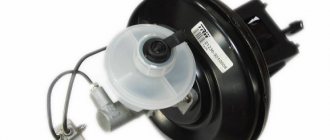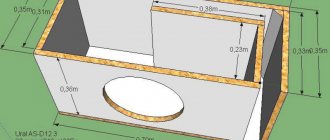Do-it-yourself noise and vibration insulation of VAZ 2115
Sound insulation and vibration insulation of a car are very important for getting rid of acoustic discomfort. Constant noise, both airborne and structural, interferes with good acoustics, does not allow you to hear your interlocutor well, quickly tires you, that is, deprives the trip of any comfort. Noises penetrate the cabin from everywhere: through the doors, underbody, engine compartment, roof, trunk. Noise and vibration insulation not only absorb vibration and prevent outside noise from entering the car interior, but also act as insulation, preventing cold from penetrating inside and keeping heat out of the car. Even foreign cars, not to mention domestic cars, including VAZ, need sound insulation (or “Shumka”).
Soundproofing a VAZ 2115 with your own hands is a fairly simple procedure, for which you will need material, a spacious room, time and, of course, knowledge. It is best to completely soundproof the car, but if you decide to do only certain sections, the result will certainly make itself felt.
As a rule, the fight to reduce noise in the cabin begins with the doors. Next, the engine compartment is soundproofed to eliminate the noise of a running engine. Soundproofing the hood of the VAZ 2115 will enhance this effect and inside the cabin, the engine at idle speed will be completely silent. The most complete sound insulation is achieved by laying vibration and noise insulating materials on the bottom, wheel arches and trunk.
Today, manufacturers of not only budget cars for some reason ignore vibration and sound insulation of the roof. There are several simple tricks to check whether your car has sound insulation or vibration insulation in the ceiling.
Sound insulation of the interior of VAZ 2113, 2114, 2115
A lack of sound insulation can be recognized if a hum and rattling is heard from the ceiling while driving, or music is hard to hear during rain. In winter, if the snow on the roof of a running car melts, there is no sound insulation or does not provide the desired effect.
Soundproofing the ceiling is the simplest procedure, which is easiest to do yourself.
Before you start soundproofing your roof, you need to buy:
- vibroplast (3 sheets 2 mm thick, good quality, for example, Noico), splen (2 sheets 4 mm thick).
Necessity of execution
Is the notorious sound insulation really necessary? Now let’s figure it out:
- In most domestic cars it is simply absent, and if present, it is only in places and the quality leaves much more to be desired
- There are rumors that there is a need for it only if you equip the car with speakers with a subwoofer (see Connection diagram for a subwoofer and speakers: its features), of course, the sound of music is significantly improved
- However, in addition to this, sounds, creaks and extraneous noises subside, which makes it possible to talk, and not yell, as before
- Today it is known that increased noise affects the nervous system and constricts blood vessels, causing stress on the heart and angina pectoris.
- And everyone wants comfort, like in the interior of an expensive foreign car.
- Therefore, my answer is unequivocal - of course it is necessary!
The work to replace the sound insulation of the VAZ 2115 ceiling takes place in several stages
Remove the trim, visors, handles, and lampshade in order to provide access to the iron base of the ceiling.
Degrease the ceiling with white spirit.
Proceed with vibration isolation, preferably with outside help, since it will not be very convenient to do it alone.
The process consists of cutting off the required piece of vibroplast and removing the protective film. Afterwards, the pieces of vibroplast are applied to the ceiling and carefully rolled out with a roller for more reliable gluing.
Apply splen on the layer of vibroplast, glue it and also roll it out with a roller. If everything is done carefully and thoughtfully, one sheet will be enough for the entire ceiling.
Then, upon completion of the vibration and noise insulation work, everything is assembled in the reverse order and secured in place.
But soundproofing the floor of the VAZ 2115, in contrast to soundproofing the ceiling, is one of the most difficult procedures. Firstly, everything that is in the cabin must be dismantled, and secondly, there are a lot of different shaped elements for which it is necessary to prepare patterns for patterns.
Try to protect yourself from noise and you will certainly feel how much more comfortable it has become in your car. Quiet music, a calm conversation with your interlocutor will bring pleasure, and rain knocking on the roof will no longer irritate you while driving.
Other interesting materials:
Based on materials from the site: https://videovaz.ru
To save fuel, our readers use Artem Abramov’s method. After carefully studying it, we decided to offer this method to you too...
Sound insulation of car doors VAZ 2114, 2113 and 2115 plays an important role in increasing driving comfort. It allows you to solve the following problems:
- significantly reduce the level of noise entering the interior from the street;
- eliminate knocks and creaks produced by internal parts and parts of the door trim;
- improve the sound quality of music in the cabin, especially if the speakers are built into the doors.
Soundproofing the doors of VAZ 2114 , 2113 and 2015 can easily be done with your own hands. The materials used are relatively inexpensive and can be purchased at almost any auto store.
The recommended standard sound insulation of the front doors of VAZ 2114, 2115 and 2113, which, as practice has shown, gives a fairly good result, consists of the following steps:
Preparatory procedures
Soundproofing work to reduce the noise level in the interior of the VAZ 2115 is reduced to 3 stages. First, the sequence of areas for sound insulation is determined. Then the necessary tools and materials are selected. Then they begin to “make noise” of the body.
Regardless of the sequence of sound insulation, a complete disassembly of the interior will be required. Drive the car to a garage or other place with sufficient space for work. Remove all seats, remove the central tunnel, visors, dashboard air ducts, steering casing and belt fixing elements. Next, the instrument panel and steering wheel are disconnected. The last step will be to dismantle the standard sound insulation of the doors, ceiling and floor. Upon completion of the disassembly, clean the interior from dirt and dust, and treat traces of paint with a solvent.
Do-it-yourself noise insulation of VAZ 2115
Removal of the casing and subsequent disassembly must be done extremely carefully. It is important to remember (or better yet, write down) the sequence of operations, the correspondence of the unscrewed bolts and screws to their holes. For convenience, you can lay out the parts on a large surface in order of disassembly. The door closing mechanism and the window lift do not need to be removed - they will not interfere with the work, but putting them back is quite difficult.
Cleaning the inside surface of the door. It is necessary to remove the factory sound insulation and other coatings that may peel off (anti-corrosion coating, etc.), but it is important not to scratch the paint. The surface of the metal must be thoroughly cleaned and degreased - for this it is recommended to use White Spirit solvent; the very bottom of the door does not need to be degreased.
Sticker of the first layer of soundproofing material. The inner surface of the panel (the wall of the door facing outwards) is pasted over with vibration-damping material (self-adhesive Vibroplast Gold STP or its equivalent is recommended) - pieces are cut approximately in the shape of the contours to which they will be glued.
This work, of course, is not easy - you need to contrive to stick “Shumka” through the openings of the technological holes, which is quite inconvenient, especially in the far corners. To avoid cutting your hands, it is advisable to work with gloves, using available means for pressing the material to the surface - a rolling roller (where it can be reached), flat tools, wooden blocks, etc. Where it is impossible to glue whole pieces, you can glue individual pieces overlapping each other, you need to cover as much surface as possible. When sticking Vibroplast, it is important not to close the drainage and ventilation holes so that condensation does not accumulate inside the door. If a circle cut from Bitoplast is glued behind the speaker on top of Vibroplast, the sound quality will improve, since the speaker will not resonate with the door.
Elimination of knocking and creaking of parts of the internal “stuffing” of the door. It is advisable to wrap all kinds of wires, rods, etc., located inside the door body with Madeline so that they do not knock when shaking; we pay special attention to the places where they come into contact with the body - here they can be wound in two layers. It is also very useful to make a Madeleine gasket along the contour of the door where the trim is attached.
Vibration isolation of technological openings. Factory-made holes are sealed with the same Vibroplast (pieces in the shape of the holes with an allowance of material along the contour for gluing).
Then it is recommended to cover the metal surface of the door on the trim side with Accent sound absorber or at least Bitoplast 10 mm thick. You should try to cover this surface completely, bringing the wires out (if any) and leaving the speaker exposed. Before this stage, it is necessary to check the serviceability of the lock mechanisms and window regulators, tighten the fasteners and, where necessary, apply lubricant.
Soundproofing of the casing. To reduce vibration and sound resonance of the casing, it is recommended to stick pieces of a vibration damper on it (preferably Vibroplast Gold) - not necessarily on the entire surface, so as not to unnecessarily weigh down the door - it is enough at the joints of the casing parts and on wide, flat areas.
Door assembly. Assemble the door, observing the correct sequence of operations. When installing the casing, replace the pistons with new ones or fasten it with self-tapping screws, where possible.
Soundproofing of doors 2114, 2115 and 2113 (rear doors and doors without audio system speakers). The technology described above is recommended for soundproofing doors that have powerful speakers installed. For doors without speakers or with low-power speakers, this procedure can be significantly simplified - just stick a layer of Vibroplast onto the panel and door trim, and also wrap the sealant around the wires and rods inside the door body.
When installing sound insulation, it is not recommended to use heavy materials - they increase the load on hinges and locks, which can lead to their deformation and problems with closing doors in the future. To increase the effect of sound insulation, it is also recommended to improve the door sealing - update the door seals or replace them with higher quality analogues.
In conclusion, it should be noted that sound insulation of the doors of VAZ 2115, 2114 and 2113 will give the desired effect only with an integrated approach, that is, if other parts of the interior are modified accordingly: hood, roof, floor, trunk, etc., otherwise on its own this operation does not make sense.
How to pay TWICE LESS for GASOLINE
- Gasoline prices are rising every day, and the car's appetite is only increasing.
- You would be happy to cut costs, but is it possible to live without a car these days!?
But there is a completely simple way to reduce fuel consumption! Don't believe me? An auto mechanic with 15 years of experience also didn’t believe it until he tried it. And now he saves 35,000 rubles a year on gasoline! Read more about this at the link.
Preparation
First of all, it is necessary to prepare the car interior for installing new sound insulation by dismantling all removable parts: seats, mats, panels. We carry out this procedure step by step:
- remove all seats:
— unscrew and remove the trim from the B pillar and door sills;
- remove the air ducts:
— carefully remove the carpet and coverings (we will need them later):
— remove the foam cushions to level the floor;
— remove the factory sound insulation:
After removing all removable parts from the interior, you must wash the floor thoroughly and thoroughly go over the metal with a degreaser.
It should be noted that in domestic cars, the drain holes at the bottom of the body are not sealed with plastic plugs, and water often enters the interior through them during bad weather. Therefore, before installing sound insulation, you should think about high-quality sealing of these holes.
Do-it-yourself noise insulation using the example of a VAZ 2114 - photo report
In order to make sound insulation for a VAZ 2114 you will need the following material:
- Vizomat MP (StP);
- Stroyizol SD 90;
- Splen 3004 (StP);
- Accent 15 LM KS (StP);
- Vibroplast Gold (StP);
- Adgilin.
Work tool:
- Ruler;
- Roulette;
- Square;
- Household hair dryer;
- Installation;
- Screwdriver Set;
- Awl;
- A set of keys;
- Scissors.
1. First of all, you need to remove everything from the interior that could get in the way - that is, everything, including upholstery, panels, etc., do everything as in the photo.
Using vibration-absorbing Vizomat MP, it is necessary to seal the entire surface of the trunk floor, see photo.
This is done in order to remove excess noise and vibration, as well as increase the rigidity of the structure. This causes a decrease in vibration levels and also shifts noise waves to the lower, low-audible frequency range. In addition, the material promotes heat retention and maintains the interior microclimate in the summer heat, keeping it cool longer than in conventional cars. To glue Vizomat MP you need a household hair dryer. Gluing occurs after the material softens and becomes soft and elastic. The adjustment of the material to the curves of the body should occur immediately, and quite quickly, but not at the expense of quality; if you delay, the material will “stiffen” and the fit will not be tight. Simply put, you will have to heat it again, in this case directly at the gluing site. In order to stick the material, you will need special rolling rollers; if you do everything yourself, the sound insulation of the car may not work or its quality will be very low.
It was not always possible to use large sheets for gluing, so I had to overlap them (15-20 mm). Remember that when gluing, you cannot seal technological holes, parts fastening elements, hatches, etc., that is, things that will need access after soundproofing.
Vibration insulation should be maximum, that is, cover the floor and ceiling with the obligatory entry under the dashboard. The sound insulation is glued on top of the vibration-proofing layer, and the end result is also good thermal insulation of the interior.
Let's summarize what the sound insulation of the VAZ 2114 gives us
1. The noise coupled with vibration isolation completely justified themselves, in addition, owners of not new cars will have the opportunity, in the literal sense, to get to know their car, or rather, its body better. As the work progressed, minor defects were discovered and eliminated: rust, anti-corrosive coating, etc.
2. Soundproofing is a very real undertaking that even the most “distant” car owners can do; there is no need for “super” skills, expensive tools or anything else, all you need is patience, desire and a lot of free time.
3. The maximum reduction in noise levels coming from outside has been achieved in the cabin. The ride has become more comfortable, the sound of the audio system has become much clearer, and now you don’t need to turn up the volume to maximum to hear words.
This material will be devoted to the topic of noise insulation, which is carried out inside the trunk and doors on a VAZ 2114 car. For the domestic “fourteenth” this is a useful measure that can significantly reduce the noise level inside the cabin, as well as in the luggage compartment. Consequently, sound insulation has a positive effect on the comfort of the driver and passengers of the car.
Photo of a door glued with Shumka on a VAZ 2114
Materials and tools
The key point is to select the optimal soundproofing material. There are ready-made kits for shielding external noise. However, all of them are modified and more expensive versions of scrap materials. For example, bitoplast is a recycled foam rubber that is perfect for soundproofing doors and ceilings. For thermal insulation, it is better to choose isolon sheets (5 mm thick and 1 m2 in area). A vibration absorber - vibroplast - will help reduce vibration of the dashboard and doors. You will need 6 sheets of 90x40 cm.
Soundproofing VAZ 2115: hood
The hood cover shields the noise of the engine compartment and is processed quite simply: Measure the parameters of the cover and prepare a cardboard sample (pattern). Using the patterns, cut out the vibration and sound insulation material.
Warm up the vibroplast with a hairdryer and apply to the cleaned and degreased surface of the lid. Cover the vibroplast with a layer of foil and cover it with a heat-insulating sheet, including the end sections.
If desired, glue factory sound insulation over the finished layer.
Door processing
After thorough cleaning, the door frame is covered with a vibration absorber. Consider ventilation and drainage openings to avoid moisture accumulation, which will render the soundproofing components unusable.
Wrap mechanical parts and wiring with anti-squeak madeleine to reduce friction and shaking. Seal the cracks with sealant.
Apply a layer of vibration material and cover it with soundproofing sheets on top.
Cover the finished layer with a decorative coating or old sheathing.
Soundproofing the doors will protect against external noise and increase the sound of the interior acoustic systems.
Trunk soundproofing
The procedure is identical to processing the hood:
Remove the old upholstery.
Clean the underbody and inner wheel arches.
After installing the vibroplast, apply bitoplast or other noise-absorbing material.
Recommendations. The area of the wheel arches and the bottom of the trunk should be shielded with 2 layers of vibration absorber. The measure is relevant when using powerful speakers, subwoofers and other acoustic systems.
Floor treatment
Once the seats and center console are removed, the floor mats are removed and the area is thoroughly cleaned, begin soundproofing the floor.
Remove old coating.
If metal areas are oxidized, wipe the surface with white alcohol, then apply paint. After drying, apply the vibration material in 2 layers, leaving the areas of the mounting bolts open.
Then insulate the floor with sound absorber.
Reassemble the seats and console in reverse order.
When the floor treatment is completed, they begin to rustle the ceiling.
Ceiling treatment
Remove the old trim by removing material from the trunk or front passenger compartment.
Install a heated vibration damper (vibroplast) and roll the surface with a roller.
Cover the top of the ceiling with any soundproofing layer.
Finally, insulate the sound insulation with a decorative coating.
Dashboard
The most labor-intensive stage of soundproofing the interior of a VAZ 2115. After dismantling the dashboard, mark the fastening points and screw the bolts back in, remember or schematically write down the location of the pads.
Remove traces of dirt, dust and degrease the inner surface.
Glue the walls of the dashboard with a layer of vibroplast.
Disconnect the hoses and electrical wiring of the stove, then remove the heating element.
The stove installation area is hermetically sealed with a heat-insulating coating.
Next, apply sound insulation overlapping.
Install the stove, connect the electrical wiring and hoses.
Doors
Sound insulation of doors has a direct impact on the level of comfort inside the VAZ 2114 car. If you carry out similar work, you will simultaneously solve several problems:
- Get rid of some of the noise that comes into the car from the outside;
- You will be able to eliminate squeaks and knocks that are typical for the VAZ 2114 due to the peculiarities of the skin and the location of internal parts;
- Improve the sound quality of your audio system. Sound insulation of VAZ 2114 doors is especially important if speakers are built into the doors.
As in the case of the trunk, door processing includes several stages:
- Disassembly. First, remove the door trim. Just do it carefully, be sure to write down or very carefully remember the dismantling sequence. This is the first and most important condition for successful reassembly.
- Surface cleaning. After removing the factory noise and other elements, clean and degrease the metal. Be careful with the paint and do not damage it with tools. The bottom of the doors does not need to be treated with degreasing compounds.
- Applying the first layer of sound insulation. To cover the walls that go outside, I use vibration damping material. The elements are cut along the contour of the compartments and glued. The work is quite difficult, since you need to manage to paste the surfaces through small holes. Wear gloves when performing noise to avoid injuring your hands on metal components. If you are gluing not a solid piece, but small pieces, do it overlapping.
- Fighting knocks and squeaks. Wrap wires, rods, and other parts that are possible using Madeline. This will avoid knocking noises when the car is shaking. Pay attention to the areas where the parts come into contact with the body. A double layer of material is allowed here. It would not be superfluous to make a continuous gasket of the same material along the entire contour of the doors where the trim is attached.
- Vibration isolation protection for technical holes. Technological holes should be treated with pieces of Vibroplast. A useful measure that gives good results in protecting against vibrations and their consequences for a comfortable ride.
- The metal surfaces of the door on the trim side are treated with Accent. This is a sound-absorbing material. If it is not there, use Bitoplast. Only the thickness of such material should not be more than 10 millimeters.
- Sheathing processing. To prevent the casing from resonating and vibrating, apply Vibroplast Gold vibration damping material to its surface. It is not necessary to cover the entire surface, since this will make the doors noticeably heavier. The most important thing is the joints of the sheathing elements and wide, even elements.
- Assembly. Before you begin assembly in accordance with your instructions, make sure that the window regulators and other elements located in the door are in good condition.
The best sound insulation is comprehensive. Therefore, it is still recommended to protect your VAZ 2114 from internal and external noise. Start small, gradually working on the roof, hood, fender liners and other elements. By doing this, you will be able to achieve amazing comfort and silence in the interior of your car.
Sources of noise and solutions
Before starting soundproofing work, it is important to determine the source of the noise. There are 3 of them in total:
- External - the sound of cars passing by, road stones and raindrops. Soundproofing of the ceiling, floor, doors and other body elements will be required.
- Internal - creaking of the steering column, rattling of the dashboard and door handles. Remedy: lubricate the working mechanisms, strengthen the dashboard fixing bolts.
- Technical - hum in the engine compartment, vibration and knocking of the driveshaft, creaking wheels. The solution comes down to repairing problem areas.
Coating operation
Replacement technology
Replacing carpet in a car is a much more difficult task than it seems at first glance. The thing is that the coating, originally installed in the cabin, is produced by hot stamping, and therefore its contours follow all the protrusions and depressions on the floor of the car. It is quite difficult to make such parts with your own hands, but we will still try to give recommendations that will help in solving this problem.
Advice! If possible, you should still try to restore the worn coating. We will tell you how to do this in the section on car mat care.
Replacing carpet in a car with your own hands involves completely dismantling the old trim.
For work we will need:
- Roll of replacement material.
- Carpet cutter.
- Sewing machine with the ability to sew carpet.
- Overlock.
- Glue, mastic or double-sided tape to secure the material.
- Hairdryer for heating the polymer insert.
The replacement instructions are as follows:
- Open the car doors and remove the seats. We also dismantle all parts that may interfere with our work.
- Carefully remove the old carpet, trying not to damage other elements of the interior trim.
- We lay out the material that is intended for replacement on the floor. Having smoothed out all the folds and smoothed the carpet, we mark the places where it is necessary to make cuts.
- If possible, then it is much easier to make a pattern according to the size and configuration of the old coating. Having made a template using this pattern, you can easily trim new material.
Part cut and sewn according to patterns
Advice! Some companies produce patterns from which you can make a pattern. True, such patterns are expensive, so it only makes sense to purchase them if you plan to install coatings on a commercial basis.
- We take out the material, lay it on a flat surface and cut holes according to the markings. We also perform trimming in those places where it is necessary for even laying on curved surfaces.
- We trim the edges of the holes with thread, and carefully sew the cut out parts on a special machine. When making seams, you need to try to ensure that the pile partially hides the stitching - to do this, you need to trim the material at a slight angle.
Advice! Such devices for processing carpets are quite expensive, so it is better to either rent one of them or simply contact a sewing shop.
- We lay the covering in the interior, checking the quality of the alignment of the holes. We moisten the material and stretch it, removing all folds.
- If you use a polymer-based material, you can heat it with a hairdryer - this will make the deformation much easier.
- It is advisable to let the carpet dry under tension. If this is not possible, we dismantle the covering, dry it and put it back in the interior.
- We finally fix the trim around the perimeter and return it to the seating area.
How to remove carpet on a car floor?
Well, if you wait, I’ll post it from Elsa. In general, from experience, if you carefully pry everything off, you won’t break anything. If you first pull the panel back a little, you can often see where it hangs. But in Elsa there is no information in one place - there is a different layout for each (almost) panel, it will take time, but it’s already night, and tomorrow is a holiday...))). It may be enough to remove the front seat, just don’t forget about the wiring. Or do you want to take everything off? - this is a hemorrhoid, the carpet is solid...
Well, here's something: -Removing and installing the floor lining on the driver's side:
– Turn off the ignition.
– Remove two screws -1- (1.5 Nm). – Remove the trim from the mountings and disconnect the wiring harness from the footwell lighting. – Press the two latches -arrows- and remove the diagnostic connector from the trim.
001npv.jpg
Removing and installing sill trims – Remove the side supports: - vehicles with rear side airbags → Chapter. — vehicles without rear side airbags → Chapter Sedan – Remove the wheel arch trim → Chapter. Variant – Remove wheel arch trim → Chapter. All vehicles – Detach the door sill trim from the front part of the sill and the door seal surround. – Release the guide -1- from the lower trim of the B-pillar. – Detach the sill trim from the rear part of the sill and the door seal surround. – Release the guide -2- from the lower trim of the B-pillar. – Move the tongue -3- to the side and remove the seat belt. NoteBefore installation, check the integrity of the fastening brackets. Replace damaged staples.
002por.jpg
Removing and installing wheel arch trim, station wagon: – Fold the rear seat cushion forward. – Remove side support: t vehicles with rear side airbags → Chapter. t vehicles without rear side airbags → Chapter – Remove screw -1- (1.5 Nm). – Detach the bracket -2- from the body flange. – Remove trim -3- from door seal edge -4-. – Remove the trim from the mountings in the sill trim -5-. – Pull out the trim in the direction of travel under the C-pillar trim -6-.
003ar.jpg
Removing and installing lower A-pillar trim on the driver's side Remove the sill trim in the transition area to the lower part of the A-pillar trim → Chapter. – Remove the side covers of the front panel → Chapter. – Remove center trim of A-pillar → Chapter.
– Remove the hood release handle -1- → External fittings; Repair group55. – Remove clip -2-. – Detach the trim from the body -arrow A-. – Remove the trim from the edge of the door seal. – Move in direction -arrow B- to remove trim from mounting. Note: Before assembly, check the condition of the clips -2- and replace any damaged ones.
004va.jpg
Removing and installing the B-pillar lower trim Removal – On vehicles with an interior security sensor, turn off the ignition. – Remove the sill trim → Chapter. – Remove upper trim of B pillar → Chapter.
– Unscrew the two screws -1- (4 Nm). – Remove the trim -3- from the edge of the door seal. – Remove the trim in the area of the guide -2- from the mountings in the body. – On vehicles with an interior monitoring sensor, disconnect the wiring harness from the sensor.
005vb.jpg
Well, it’s clear from the seat:
006sv.jpg
Well, won't it help? Personally, I would limit myself to removing the front seat and clean it directly in the car. It is best, of course, to clean the steam generator using chemicals, a brush and a vacuum cleaner. You can use perchlorethylene, but you need a friend from the dry cleaner and chemical protection during work... And the most harmless way is to take LOC from Amway, a stiff brush and walk it three times and dry it... Resuscitator of the site and forum. Register and take part in discussions.
How to clean the carpet in a car yourself
Cleaning the car should be done in a top-down manner. And now you have finally reached the carpeting in the interior of your car.
There is no universal recipe for cleaning carpet for all types of cars, because each line of numerous car brands has different types of carpets, different materials from which they are made, and different types of pile. What works great for some cars may not work for others. Therefore, if you can’t get rid of stains and dirt, I use one product and try another
We try it carefully, on a small area of the carpet, because if you use the wrong chemicals, then the likelihood of deformation and damage to the carpet pile, loss of color and other changes in the structure of the carpet fibers will increase.
The floor of a car is not a flat carpet; it has many narrow places. For these hard-to-reach places, use the corner of a folded rag or swab or ear sticks. As a last resort, the dust is blown off with an aerosol can of compressed air, which is used when cleaning computers.
First, vacuum the floor covering. And then we use one of the methods below, personally tested by a large number of car enthusiasts.
The simplest thing is to buy both a suitable chemical special automotive product and just a household chemical product. A very simple rule applies here: everything you use at home to clean similar surfaces can be used in your car. We won't talk about special vehicles. Their choice depends on the range of auto chemicals in stores in your region. Let's look at the simplest and most commonly available methods for cleaning carpet in a car.
It is advisable to remove carpet mats. It's good if you have a Karcher or a washing vacuum cleaner.
We buy Vanish for cleaning carpets and sofas. We dilute and apply foam. Take a lint brush for clothes and rub it with even force. We don’t use a hard brush, as it can ruffle the pile. Then we take a damp cloth (well wrung out) and remove the layer of foam that is dirty. Apply foam again. Three again. Remove with a cloth. When the dirt is washed off, wipe with a dry cloth and leave to dry or use a hair dryer. After drying, we vacuum the interior again.
If you did this without removing the carpets, do not pour too much water so that water does not seep into the holes in the carpet and the bottom begins to rot.
You can use other carpet cleaning products. For example, Cinderella carpet cleaner. It's inexpensive and cleans well. So, inexpensive “Soviet” carpet cleaning products do an excellent job of removing stains. And they cost pennies.
You can also clean the car using Fairies.
And here is another one of the simplest and most frequently used ways to clean a car interior - using a soap solution. They use both regular scented soap and laundry soap.
Take a bucket. Pour warm water into it. Shape the soap. Let stand for 10-20 minutes until it dissolves. Next, beat the foam with a sponge and lather the carpet surface with this foam. Three soft brushes. We collect dirty foam with a cloth or vacuum cleaner. Repeat the procedure until completely clean.
To clean the carpet, you can also use washing powder (Tide, Ariel and others).
It is not recommended to wash carpet rugs in a washing machine. The bottom impregnation of the mat may be damaged.
This might be interesting
- How to register for an engine replacement in a car Do I need to register for an engine replacement in a car? In which cases? What documents are needed for...
- On bicycles through the mountains This is a report on a journey by bicycles through the Caucasus Mountains of completely unprepared people. Read this article and you...
- Car loan. Article 5. Reviews about car loans It’s up to you to decide whether to take out a car loan or not. We publish reviews from consumers and car owners who at one time...

